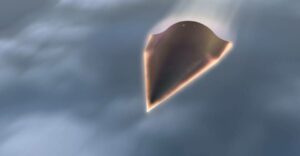WASHINGTON — The U.S. commander in the Indo-Pacific considers domination of the electromagnetic spectrum, which militaries rely upon for weapons guidance, communications and deception, a top priority that requires additional resources.
Navy Adm. John Aquilino, who leads the China-focused Indo-Pacific Command, told the Senate Armed Services Committee April 20 that “immediately behind” the pressing demand for beefed up Guam missile defense stands another need for so-called decision superiority, or the ability to find, classify, target and knock out foreign threats, among other actions.
RELATED

“We need to be able to operate in contested space,” he said. “We need persistent battlespace awareness of all things going on, and we need to be able to close our kill chains with the weapons and the networks that allow that to happen. The electromagnetic spectrum is critical to that.”
Electronic warfare is a fight over the spectrum, and is increasingly important as militaries across the world deploy growing numbers of digital-first systems. The contest for spectrum superiority in any conflict involving the U.S., China or Russia is expected to be fierce.
The Pentagon is rebuilding its EW arsenal after decades of post-Cold War atrophy and years spent in the Middle East fighting forces with lesser equipment. An Air Force official in September, for example, said the service is “nowhere near” where it needs to be concerning the spectrum and, as a result, is reviewing its deficiencies and potential solutions.
INDOPACOM’s fiscal 2024 unfunded priorities list, totaling nearly $3.5 billion, includes items Aquilino said would “provide benefit in the electromagnetic spectrum, in order to execute our mission.” Military leaders submit the inventories, colloquially known as wish lists, each year to lawmakers as legally required. They allow defense officials to highlight for Congress items that did not make it into the latest budget request from the White House but that would be useful, should money be available.
The command’s “wish list” includes hundreds of millions of dollars for better tracking, targeting and international coordination. It also seeks an additional $184 million for offensive cyber capabilities, $90 million for cybersecurity and network hardening, $45.4 million for signals intelligence upgrades and $11.3 million for influence campaigns.
Sen. Jack Reed, the chairman of the Senate Armed Services Committee, said Aquilino faces a tricky juggle of priorities and investments, and that “one area, which seems critical, is the electromagnetic spectrum.”
RELATED

“To successfully conduct operations in the Pacific, ideally, you could disrupt the communication of our enemies and also their ISR, and, at the same time, in a complementary fashion, disguise our assets and also have constant, secure communication,” the Rhode Island Democrat said.
Jamming and spoofing, among other electronic warfare techniques, would be critical in that regard.
Reed previously told reporters the U.S. needs to rethink how it fights its fights, including across the spectrum. Technologies and their respective applications are rapidly evolving, he said in February, producing a “tremendously dynamic situation.”
Colin Demarest is a reporter at C4ISRNET, where he covers military networks, cyber and IT. Colin previously covered the Department of Energy and its National Nuclear Security Administration — namely Cold War cleanup and nuclear weapons development — for a daily newspaper in South Carolina. Colin is also an award-winning photographer.
- SEO Powered Content & PR Distribution. Get Amplified Today.
- Platoblockchain. Web3 Metaverse Intelligence. Knowledge Amplified. Access Here.
- Minting the Future w Adryenn Ashley. Access Here.
- Source: https://www.defensenews.com/electronic-warfare/2023/04/20/indopacoms-aquilino-seeks-more-electromagnetic-resources-for-pacific/
- :has
- :is
- :not
- $3
- $UP
- 1
- 11
- 20
- 2023
- 2024
- 70
- 8
- a
- ability
- Able
- across
- actions
- Additional
- administration
- advanced
- After
- AIR
- Air Force
- aircraft
- All
- also
- among
- an
- and
- Another
- any
- applications
- April
- ARE
- AREA
- armed
- Army
- Arsenal
- artist
- AS
- Assets
- At
- attack
- available
- award-winning
- awareness
- BE
- been
- benefit
- Better
- Billion
- budget
- build
- Campaigns
- capabilities
- Center
- chains
- chairman
- chief
- China
- Classify
- Close
- committee
- Communication
- Communications
- complementary
- Conduct
- conflict
- Congress
- considers
- constant
- contest
- Contractor
- coordination
- could
- covered
- covers
- critical
- cyber
- Cybersecurity
- daily
- decades
- decision
- Defense
- Demand
- Democrat
- Department
- Department of Energy
- deploy
- Development
- DID
- Disrupt
- dollars
- during
- dynamic
- each
- East
- Electronic
- enemies
- energy
- equipment
- Ether (ETH)
- evolving
- example
- execute
- expected
- faces
- Fashion
- February
- fierce
- fight
- fighting
- fights
- Find
- For
- Force
- Forces
- foreign
- Formally
- from
- future
- going
- Growing
- guidance
- happen
- Have
- he
- head
- helicopter
- Highlight
- House
- How
- http
- HTTPS
- Hundreds
- hundreds of millions
- image
- images
- important
- in
- includes
- Including
- increasingly
- influence
- Intelligence
- International
- into
- Investments
- island
- IT
- items
- ITS
- jack
- John
- Kill
- known
- latest
- lawmakers
- leaders
- Leads
- lesser
- Lists
- make
- March
- Mass
- Middle
- Middle East
- militaries
- Military
- million
- millions
- Mission
- money
- more
- namely
- National
- nearly
- Need
- needs
- network
- networks
- nuclear
- Nuclear weapons
- numbers
- of
- offensive
- official
- on
- operate
- Operations
- or
- order
- Other
- our
- over
- Pacific
- pentagon
- photographer
- plato
- Plato Data Intelligence
- PlatoData
- potential
- previously
- priority
- rapidly
- receives
- rendering
- reporter
- request
- required
- requires
- Resources
- respective
- result
- reviewing
- s
- Said
- same
- Screen
- secure
- security
- Seeks
- seems
- selected
- Senate
- September
- service
- Services
- should
- signals
- Singapore
- situation
- Solutions
- South
- South carolina
- Space
- specialist
- Spectrum
- spent
- stands
- submit
- Successfully
- Systems
- Target
- targeting
- Technologies
- that
- The
- the world
- their
- things
- threats
- time
- to
- top
- Tracking
- trip
- u.s.
- upgrades
- war
- we
- Weapons
- which
- white
- White House
- WHO
- with
- world
- would
- year
- years
- you
- zephyrnet












